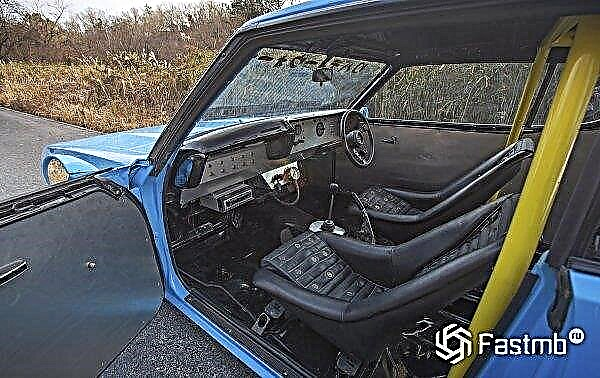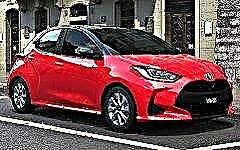Review of the tuned Nissan Skyline C-GC111. Why do you need a muffler for a dredge? So is the speedometer and other indicators? The main thing is that the tires are wider and more powerful under the hood ...

The Kenmeri GC111 Nissan Skyline is a collaboration between two well-known companies Liberty Walk and Mizuno Works. Japanese classic cars like this are interesting in that they can be built, tuned, and rebuilt in many different ways. Very often they are a direct reflection of the character and taste of their owner.
In its past life, this 1998 C-GC111 Kenmeri was not a rare KPGC110 2000GT-R, so Kato-san, the creator of the LBW brand, did not hesitate for a moment before turning it into a great blend of Yankee style and powerful supercar.
Body tuning Nissan Skyline GC111

The creation of Kenmeri began with the preparation of the chassis, the rest of the parts began to be mounted on it. The original Mizuno Works fender flares were attached directly to a freshly painted body covered with Ice blue pearl paint, which gives the surfaces a unique depth.

This car has a very low stance - the distance from the bottom to the road surface is exactly 5 mm. Such a small ground clearance is achieved by special short-travel Mizuno 92 shock absorbers installed in each of the corners of the body. For them, springs have been carefully chosen to absorb impacts and ensure that the car does not crash if it drives over even the smallest potholes found on a normal road. In general, this car is more intended for display at exhibitions, it is unlikely that Kato would like to use it in real conditions.


The Kenmeri Skyline is minimalist in appearance, from the painted bumper to the protruding spoiler lip attached to the stern. The front grille is removed, the headlights have a mandatory characteristic Yankee-style slope and an external oil cooler slapped to the front end - this is also a kind of "must have", a kind of hint at Hakosuka and other representatives of Japanese classics that raced on the Fuji track in the seventies.

You will notice that the entire rear of the car is flattened and has no bumper. It is a true Japanese racing car with a Bosozoku look and feel. The Nissan Cherry pivoting taillights are just an addition. There is not even a recess for installing a license plate.

This supercar has the widest wheels available - 14-inch steel wheels with variable horizontal width (10 inches in the front and 13 inches in the rear). It is almost impossible to find rubber on these wheels, so Kenmeri is shod with vintage Advan racing tires.
Engine from Mizuno Works


The heart of the engine is an all-new LD28 metal crank, connecting rods and 89.25mm AS Watanabe pistons. Together, they allow an increase in engine displacement from 300 cc to 3.1 liters, and work at a higher fuel pressure. The piston head has been hand polished. The intake and exhaust ports have also been carefully finished.


The Engine Works camshaft (77 degrees) presses the valves, which are enlarged to 46 mm for the intake and 38 mm for the exhaust. Three Mikuni carburetors (diameter 44 mm) provide air and fuel mixing.

There is a completely unbranded stainless steel exhaust manifold. But there is no muffler as such. The sound is very loud and unpleasant, although it will do just fine for drifting. In order to make each cylinder work more efficiently, an Ultra MDI block has been added to amplify the intensity of the spark coming from NGK spark plugs.
Kenmeri salon

Photos of the salon drag-classic Nissan Skyline GC111
As soon as the heavy steel doors are thrown open, the cabin opens, in which minimalism reaches its maximum. In the opinion of the Japanese, only the Datsun steering wheel should be in the cockpit. Nothing superfluous and everything that could affect the weight of the car - it was so in the seventies, exactly the same approach remains today. That is why instead of the instrument panel there is an aluminum sheet: all the factory "stuffing" has been removed from the cab completely. There is nothing to see here: just a couple of analog devices.


There are four more simple measuring tools from Omori. A tachometer is located behind the steering wheel. It so happens that you can not be distracted by the speedometer - it simply does not exist. On the left, there are three more Omori dials that record temperature, oil pressure and water temperature.

Any Nissan enthusiast will sell his soul for a set of original Datsun sports seats. These are the chairs Kato ordered for this car. Perhaps superfluous can be considered the presence of Carrozzeria headrests and a pair of speakers in the luggage compartment. However, they are an integral part of the author's design.
Conclusion

It is very difficult to present such machines to the public, which is mostly non-Japanese. Even among the Japanese, there are many who do not accept Shakotan. Don't like the end result? It doesn't matter. Kato and others who do this kind of work don't pay much attention to it. They want to feel satisfaction from the creative process, from the fact that they are creating something unique. And there is nothing wrong with that.











